Spain's open data initiative, datos.gob.es, is revamped to offer a more accessible, intuitive and efficient experience. The change responds to the desire to improve access to data and facilitate its use by citizens, researchers, companies and administrations. With an updated design and new functionalities, the platform will continue to act as a meeting point for all those who seek to innovate based on data.
Focus on high-value datasets and web services
The new website reinforces its central axis, the National Open Data Catalogue, an access point to nearly 100,000 datasets, which group more than 500,000 files, and which the Spanish Public Administration makes available to companies, researchers and citizens for reuse. In it you can find datasets published by bodies of the General State Administration, regional, local, universities, etc.
One of the most relevant advances is the improvement in the possibilities for data publishers to describe in a more precise and structured way the data collections they wish to make available to the public. A more detailed description of the sources makes it easier for users to locate data of interest.
Specifically, the platform incorporates a new metadata model aligned with the latest versions of European standards, the national application profile DCAT-AP-ES, which adapts guidelines from the European metadata exchange scheme DCAT-AP (Data Catalog Vocabulary – Application Profile). This profile improves interoperability at national and European level, facilitates compliance with EU regulations, favors the federation of catalogues and the localization of datasets, and contributes to improving the quality of metadata through validation mechanisms, among other advantages.
In addition, the new version of datos.gob.es introduces significant improvements to the Catalog view, highlighting high-value data (HVD) and data offered through web services. To improve their identification, distinctive symbols have been added that allow you to differentiate the types of resources immediately.
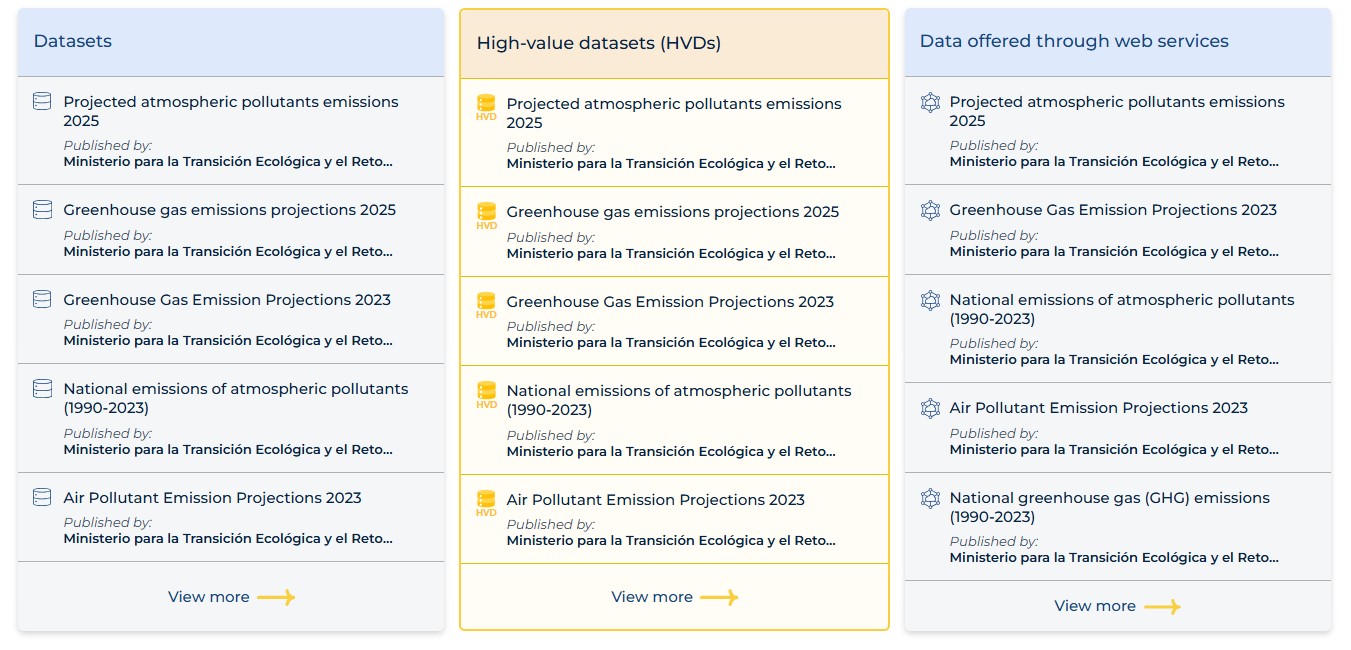
Likewise, the number of documented metadata has been expanded, which is shown to users through a clearer structure. Metadata provided by publishers can now be categorized into general information, data sheet, contact and quality aspects. This new organization provides users with a more complete and accessible view of each dataset.
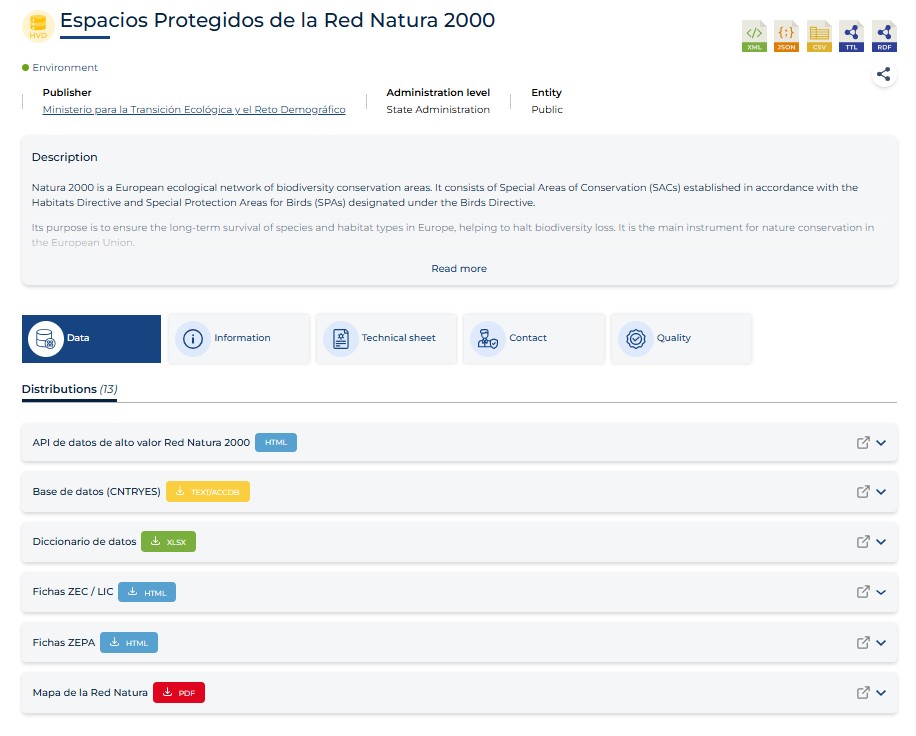
It is also worth noting that the data request process has been optimized to offer a more intuitive and fluid experience.
A new information architecture to improve usability
The new datos.gob.es platform has also adapted its information architecture to make it more intuitive and improve navigation and access to relevant information. The new settings make it easier to locate datasets and editorial content, while contributing to accessibility, ensuring that all users, regardless of their technical knowledge or device type, can interact with the website without difficulties.
Among other issues, the menu has been simplified, grouping the information into five large sections:
- Data: includes access to the National Catalogue, along with forms to request new data to be published as open. Information on data spaces and safe environments can also be found in this section, along with a section on resources for publisher support.
- Community: designed to learn more about open data initiatives in Spain and be inspired by examples of reuse through various use cases, organized into companies and applications. It should be noted that the map of initiatives has been updated with revised and improved files, with the option of filtering by the category of data offered, making it easier to consult. In this section we also find information on the challenges and the subsection of sectors, which has been considerably expanded, incorporating all those defined by the Technical Standard for Interoperability of Reuse of Information Resources, which allows a more complete view of both the data and its potential for use according to each area.
- News: users will be able to keep up to date with the latest developments in the data ecosystem through news and information on events related to the subject.
- Knowledge: one of the main novelties of the new platform is that all the resources that seek to promote data-based innovation have been unified under a single heading, making it easier to organize. Through this section, users will be able to access: blog articles, written by experts in various fields (data science, data governance, legal aspects, etc.), where trends in the sector are explained and analyzed; data exercises to learn step by step how to process and work with data; infographics that graphically summarize complex use cases or concepts; interviews with experts in podcast, video or written formats; and guides and reports, aimed at both publishers and reusers of data. Also included is the link to the GitHub repository, whose visibility has been strengthened in order to promote access and collaboration of the data community in the development of open tools and resources.
- About us: in addition to information about the project, FAQs, contact, platform technology, etc., in this section you can access the new dashboard, which now provides more detailed metrics on the catalog, content, and outreach actions.
The new version of datos.gob.es also introduces key improvements to the way content and datasets are located. The platform has been optimized with an intelligent search, which allows a guided search and a greater number of filters, making it easier to find information faster and more accurately.
Improved internal functionalities
The new version of datos.gob.es also brings with it internal improvements that will facilitate management for data publishers, optimizing processes. The private part accessed by agencies has been revamped to offer a more intuitive and functional interface. The console has been redesigned to streamline data management and administration, allowing for more efficient and structured control.
In addition, the content manager has been updated to its latest version, which guarantees better performance.
These enhancements reinforce datos.gob.es's commitment to the continuous evolution and optimization of its platform, ensuring a more accessible and efficient environment for all actors involved in the publication and management of open data. The new platform not only improves the user experience, but also drives data reuse across multiple industries.
We invite you to explore what's new and reap the benefits of data as a driver of innovation!
The YouTube channel of datos.gob.es (@datosgob) has been revamped with the aim of improving the user experience. Thanks to an updated design and the addition of new playlists, the channel facilitates access to content related to data and innovative technologies in a more intuitive and efficient way.
What can you find on the datos.gob.es YouTube channel?
Through various lists, the videos are grouped into thematic categories, making it easier to locate topics of interest and contributing to a more user-friendly navigation. Below, we present each of the lists that you can find on the channel:
1. Learn about data
This playlist is oriented towards educational content related to the world of data and related technologies. Here you can find videos that explain in a simple way basic concepts, current trends, technical specifications and other interesting topics. The aim of this section is to provide content accessible to all, regardless of their level of knowledge in the area of data.
For example, you will find videos with explanations on the impact of open data on society, illustrated through concrete use cases, or good practices for facing a data analytics project. You will also be able to access content related to the UNE Data Specifications, which are normative and informative resources for implementing common data governance, management and quality processes.
With this list, the aim is to provide education to the audience and increase awareness of the potential of data.
Access the "Learn about data" list
2. Get to know datos.gob.es
The second playlist, "Conoce datos.gob.es", focuses on providing specific information about the portal and its functions. Here you will find videos explaining technical, administrative or navigation aspects related to the use of the datos.gob.es platform.
With these videos, public bodies can, for example, find out how to create a user account and be able to automatically publish open datasets on the portal. On the other hand, for those who want to reuse the data, there are short videos showing how to use the API of datos.gob.es, the SPARQL point or the widget, among others.
It is a list designed for those who need practical guidance to use the portal efficiently.
Access the list "Get to know datos.gob.es
3. Interviews
The channel also includes a playlist featuring conversations in question-and-answer format with leading professionals in various data-related areas. These videos are an opportunity to listen to specialists and hear their opinions on topics such as digitisation, artificial intelligence or the use of data in different sectors.
Among the interviewees, we find representatives from the public sector, who explain their data openness strategies, the functionalities available in their open data platforms or the challenges they have faced in making various datasetsavailable to the public. Interviews with private companies with data sharing initiatives (such as Microsoft, Meta or Google) have also been published, communities of data reusers (such as R Ladies or R Hispano) or foundations and associations linked to data use and innovation (such as ASEDIE or the COTEC Foundation).
This list is aimed at those who want to learn more about publishing and using data through testimonials, experiences and examples.
4. Reports
This list presents interviews with authors of guides, reports and studies produced within the framework of the Aporta Initiative and included in the "Documentation" section of datos.gob.es. In these videos, interviewees answer specific questions related to the content of their reports, allowing viewers to understand the highlights of each document.
Available videos explain guidelines such as "Synthetic data:". What are they and what are they used for?" or "Introduction to data anonymisation: techniques and case studies", among other reports.
This approach makes it easier to understand the topics covered and allows the audience to discover which reports they can dig into to learn more about the issues they are interested in.
5. Data science exercises
On the datos.gob.es portal you can find a series of exercises that make use of the open data available on the platform itself or other similar catalogs. They address and describe the steps necessary to obtain the data, perform the relevant transformations and analysis, and draw conclusions, so that users can replicate the exercise in a simple way using free tools. All the material generated is available for reuse in the GitHub repository of datos.gob.es.
The “Data Science Exercises” playlist offers videos in which the author of each exercise exposes the contents that users will find in the exercise. These videos are designed to provide practical and straightforward guidance for performing interactive visualisations, building an expert assistant or performing predictive analytics, among others.
It is an excellent choice for users who want to learn and practice data science, applying concepts in real scenarios in an effective way.
Access the list "Data science exercises"
6. Podcasts
Another new feature is the incorporation of a playlist with clips from the podcasts produced by datos.gob.es and available on the SoundCloud platform.
These videos present selected excerpts from podcasts in which speakers talk about a variety of topics, always related to data and its impact on society. The podcasts are accompanied by related images, offering a complementary visual experience.
Thanks to these clips, users will be able to discover what high-value data is or where to locate data with a geographic component.
This is an alternative for those who want to discover highlights before listening to a full podcast.
Access the "Pódcast clip" list
7. Desafíos Aporta
The Aporta Challenges are competitions aimed at identifying and recognising new ideas and prototypes that improve efficiency in a specific sector of activity through solutions based on the use of open data.
There are four playlists linked to the Aporta Challenges, one for each edition held so far. For easy identification, each video has the logo of the corresponding edition on the cover.
These lists include guides on how to participate, interviews with participants or videos summarising the development of each competition.
Access the list "Desafíos Aporta"
8. Encuentros Aporta
Finally, the channel also has several playlists that collect the materials generated in each of the Encuentros Aporta, conferences focused on different topics of interest related to data.
Following a structure similar to that of "Desafíos Aporta", each list includes videos of different nature, such as summaries, full papers and interviews with participants from each available edition (the first two editions were not recorded). To make it easier to find, each video also carries the logo of the corresponding edition on its cover, allowing viewers to quickly identify the content of each encounter.
Access the list "Encuentros Aporta"
With these new features on the datos.gob.es YouTube channel, the portal demonstrates its commitment to improving the user experience, offering accessible and enriching content. Those interested in the world of data now have a revamped platform at their disposal, where they can learn, inform themselves and delve into key topics in a simple and orderly manner.
Just a few days before the end of 2022, we’d like to take this opportunity to take stock of the year that is drawing to a close, a period during which the open data community has not stopped growing in Spain and in which we have joined our joint forces and desires with the Data Office. The latter unit is responsible for boosting the management, sharing and use of data throughout all the production sectors of the Spanish Economy and Society, focusing its efforts in particular on promoting spaces for sharing and making use of sectoral data.
It is precisely thanks to the incorporation of the Data Office under the Aporta Initiative that we have been able to double the dissemination effect and promote the role that open data plays in the development of the data economy.
Concurrently, during 2022 we have continued working to bring open data closer to the public, the professional community and public administrations. Thus, and with the aim of promoting the reuse of open data for social purposes, we have once again organised a new edition of the Aporta Challenge.
Focusing on the health and well-being of citizens, the fourth edition of this competition featured three winners of the very highest level and the common denominator of their digital solutions is to improve the physical and mental health of people, thanks to services developed with open data.
New examples of use cases and step-by-step visualisations
In turn, throughout this year we have continued to characterise new examples of use cases that help to increase the catalogue of open data reuse companies and applications. With the new admissions, datos.gob.es already has a catalogue of 84 reuse companies and a total of 418 applications developed from open data. Of the latter, more than 40 were identified in 2022.
Furthermore, since last year we inaugurated the step-by -step visualisations section, we have continued to explore their potential so that users can be inspired and easily replicate the examples.
Reports, guides and audio-visual material to promote the use of open data
For the purpose of continuing to provide advice to the communities of open data publishers and reusers, another of the mainstays in 2022 has been a focus on offering innovative reports on the latest trends in artificial intelligence and other emerging technologies, as well as the development of guides , infographics and videos which foster an up-close knowledge of new use cases and trends related with open data.
Some of the most frequently read articles at the datos.gob.es portal have been '4 examples of projects by private companies that are committed to open data sharing', 'How is digital transformation evolving in Spain?' either 'The main challenges to promote sectoral data spaces', inter alia. As far as the interviews are concerned, we would highlight those held with the winners of the 4th “Aporta” Challenge, with Hélène Verbrugghe, Public Policy Manager for Spain and Portugal of Meta or with Alberto González Yanes, Head of the Economic Statistics Service of the Canary Islands Institute of Statistics (ISTAC), inter alia.
Finally, we would like to thank the open data community for its support for another year. During 2022, we have managed to ensure that the National Data Catalogue exceeds 64,000 published data sets. In addition, datos.gob.es has received more than 1,300,000 visits, 25% more than in 2021, and the profiles of datos.gob.es on LinkedIn and Twitter have grown by 45% and 12%, respectively.
Here at datos.gob.es and the Data Office we are taking on this new year full of enthusiasm and a desire to work so that open data keep making progress in Spain through publishers and reusers.
Here's to a highly successful 2023!

If you’d like to see the infographic in full size you can click here.
** In order to access the links included in the image itself, please download the pdf version available below.
A symptom of the maturity of an open data ecosystem is the possibility of finding datasets and use cases across different sectors of activity. This is considered by the European Open Data Portal itself in its maturity index. The classification of data and their uses by thematic categories boosts re-use by allowing users to locate and access them in a more targeted way. It also allows needs in specific areas to be detected, priority sectors to be identified and impact to be estimated more easily.
In Spain we find different thematic repositories, such as UniversiData, in the case of higher education, or TURESPAÑA, for the tourism sector. However, the fact that the competences of certain subjects are distributed among the Autonomous Communities or City Councils complicates the location of data on the same subject.
Datos.gob.es brings together the open data of all the Spanish public bodies that have carried out a federation process with the portal. Therefore, in our catalogue you can find datasets from different publishers segmented by 22 thematic categories, those considered by the Technical Interoperability Standard.
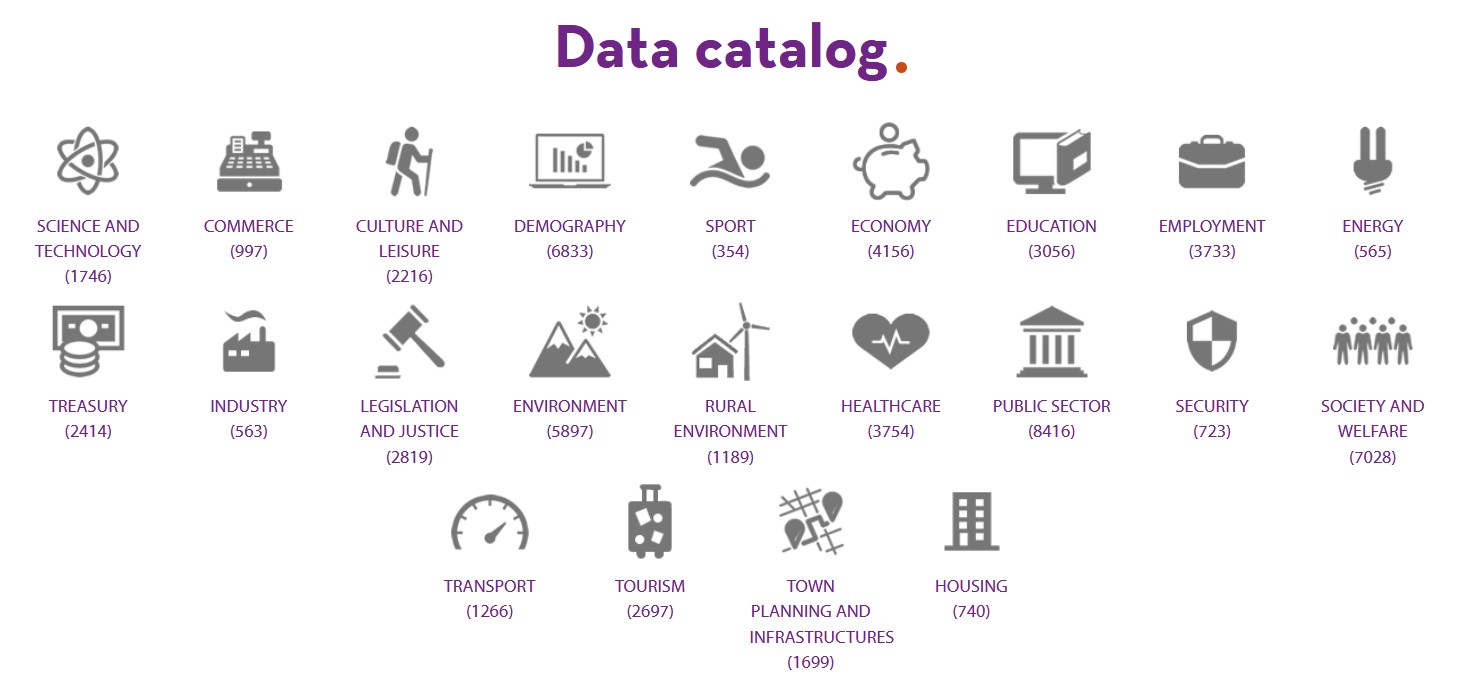
Number of datasets by category as of June 2021
But in addition to showing the datasets divided by subject area, it is also important to show highlighted datasets, use cases, guides and other help resources by sector, so that users can more easily access content related to their areas of interest. For this reason, at datos.gob.es we have launched a series of web sections focused on different sectors of activity, with specific content for each area.
4 sectorial sections that will be gradually extended to other areas of interest
Currently in datos.gob.es you can find 4 sectors: Environment, Culture and leisure, Education and Transport. These sectors have been highlighted for different strategic reasons:
- Environment: Environmental data are essential to understand how our environment is changing in order to fight climate change, pollution and deforestation. The European Commission itself considers environmental data to be highly valuable data in Directive 2019/1024. At datos.gob.es you can find data on air quality, weather forecasting, water scarcity, etc. All of them are essential to promote solutions for a more sustainable world.
- Transport: Directive 2019/1024 also highlights the importance of transport data. Often in real time, this data facilitates decision-making aimed at efficient service management and improving the passenger experience. Transport data are among the most widely used data to create services and applications (e.g. those that inform about traffic conditions, bus timetables, etc.). This category includes datasets such as real-time traffic incidents or fuel prices.
- Education: With the advent of COVID-19, many students had to follow their studies from home, using digital solutions that were not always ready. In recent months, through initiatives such as the Aporta Challenge, an effort has been made to promote the creation of solutions that incorporate open data in order to improve the efficiency of the educational sphere, drive improvements - such as the personalisation of education - and achieve more universal access to knowledge. Some of the education datasets that can be found in the catalogue are the degrees offered by Spanish universities or surveys on household spending on education.
- Culture and leisure: Culture and leisure data is a category of great importance when it comes to reusing it to develop, for example, educational and learning content. Cultural data can help generate new knowledge to help us understand our past, present and future. Examples of datasets are the location of monuments or listings of works of art.
Structure of each sector
Each sector page has a homogeneous structure, which facilitates the location of contents also available in other sections.
It starts with a highlight where you can see some examples of outstanding datasets belonging to this category, and a link to access all the datasets of this subject in the catalogue.
It continues with news related to the data and the sector in question, which can range from events or information on specific initiatives (such as Procomún in the field of educational data or the Green Deal in the environment) to the latest developments at strategic and operational level.
Finally, there are three sections related to use cases: innovation, reusing companies and applications. In the first section, articles provide examples of innovative uses, often linked to disruptive technologies such as Artificial Intelligence. In the last two sections, we find specific files on companies and applications that use open data from this category to generate a benefit for society or the economy.
Highlights section on the home page
In addition to the creation of sectoral pages, over the last year, datos.gob.es has also incorporated a section of highlighted datasets. The aim is to give greater visibility to those datasets that meet a series of characteristics: they have been updated, are in CSV format or can be accessed via API or web services.
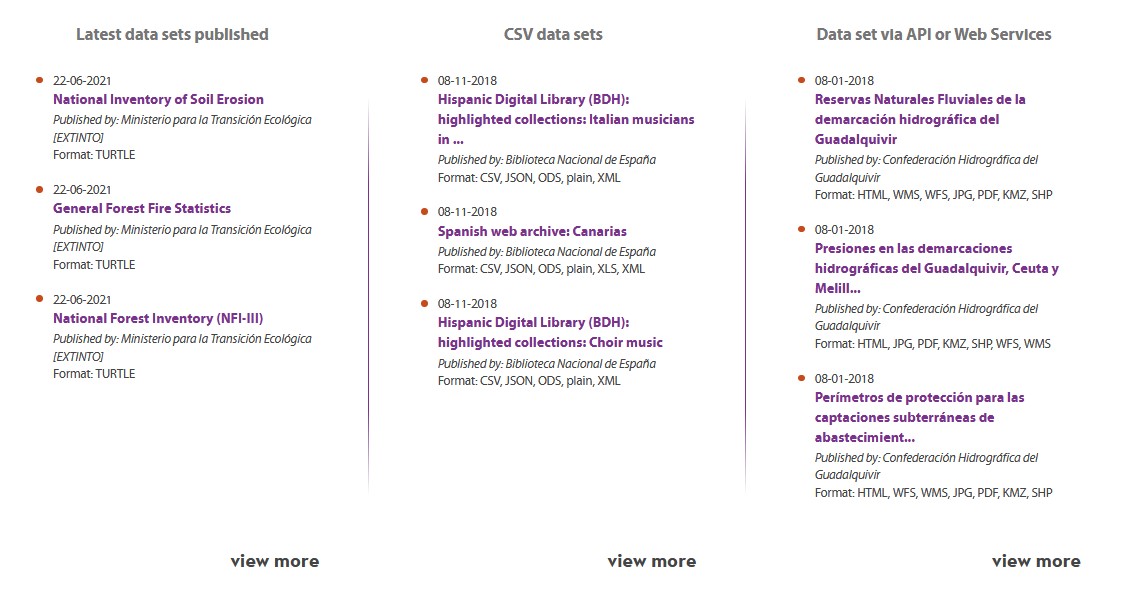
What other sectors would you like to highlight?
The plans of datos.gob.es include continuing to increase the number of sectors to be highlighted. Therefore, we invite you to leave in comments any proposal you consider appropriate.
When launching an open data initiative, there are many issues to consider: what data I will include, what technical infrastructure I need, which governance model will be developed, how to monitor the activity... and also how to design and development the portal used by citizens to interact with the published data.
In addition to a data catalog, many open data portals usually include other types of sections and services that seek to provide added value to users. It is not uncommon to find sections where use cases are collected, blogs with articles that explain the latest technological trends or support services where users can send their doubts. But, are user interested in this type of services?
In order to know what services are useful and should be included in an open data portal, the best option is to directly ask users. And that is just what datos.gob.es has done. Through a small survey – you can still participate-, users have told us what their needs and interests are. Here are some of the main conclusions:
- The most interesting section of datos.gob.es is the data catalog, followed by the applications and documentation sections. The catalog is the central core of an open data portal, but users also look for examples that show the opportunities of reusing shared information, as well as guides and training materials

- In the same line, the most useful topics are those that explain new technological models or provide examples of data value for administrations, companies and citizens. Also highlight the data training documents, especially those related to new profiles and new skills.
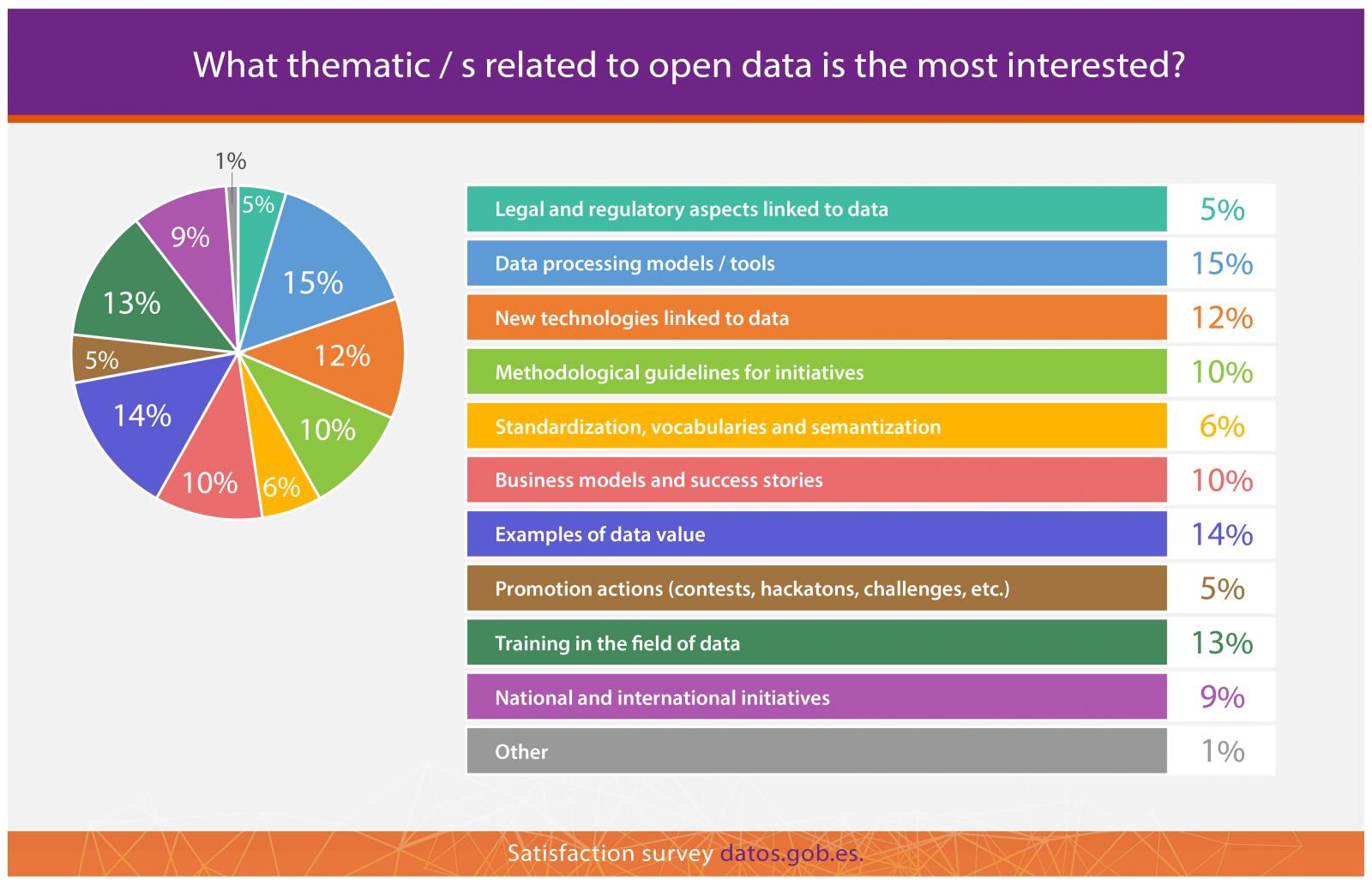
- With regard to the services offered, users show a similar interest in the different options. The most important is the federation service, which highlights the value of having automatic data publication services. In addition, services aimed at both publishers and reusers are valued in equal measure. Having a support service for publishers or re-users requests can increase the value of your initiative.
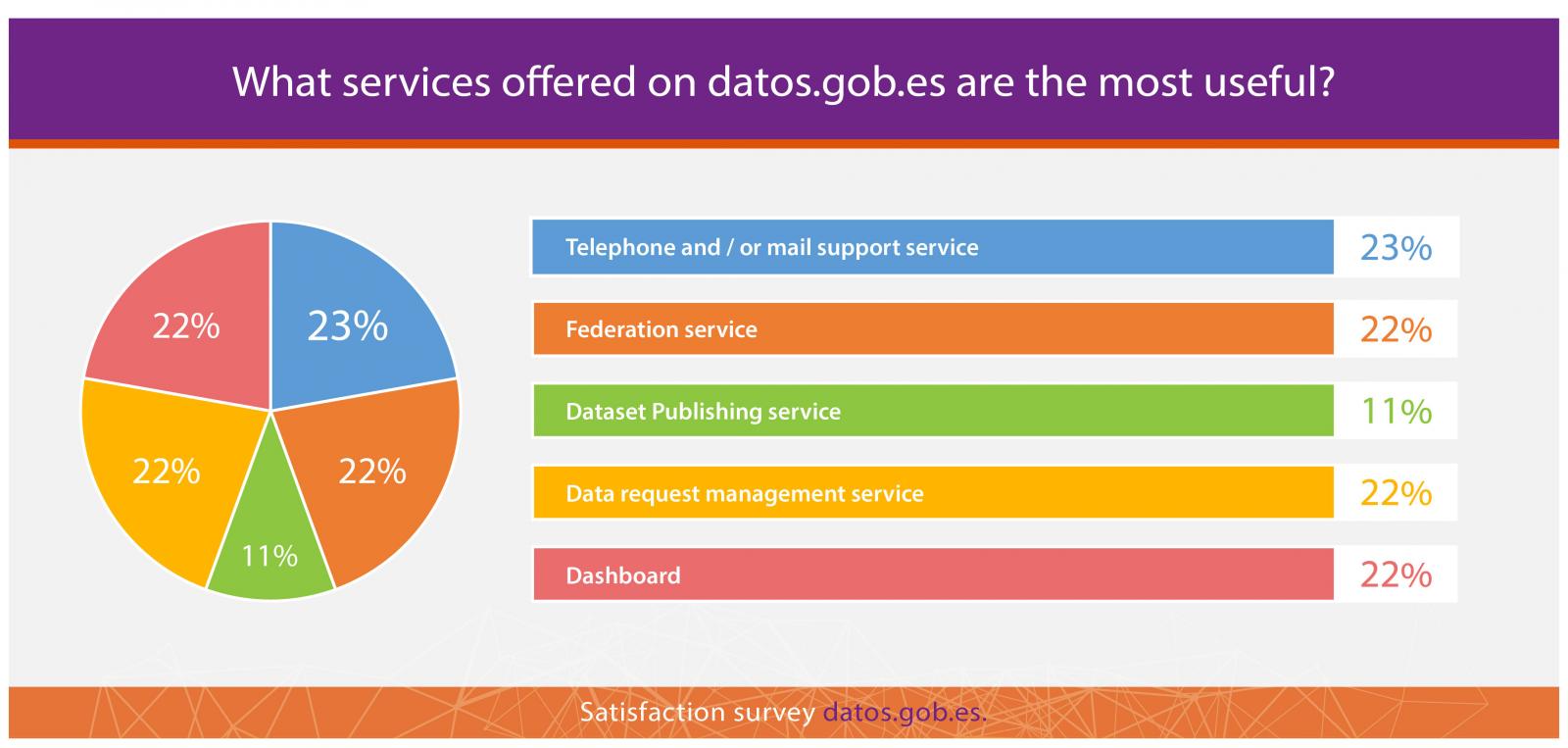
- When choosing to create an open data portal, one of the main objectives is increase the number of users that access and reuse the information. Therefore, it is appropriate to include in our strategy actions that promote the use of published data to generate new services and products that provide social or economic value. Among all the actions that can be carried out, training stand out the most, as well as the publication of examples. This is aligned with the previous questions.
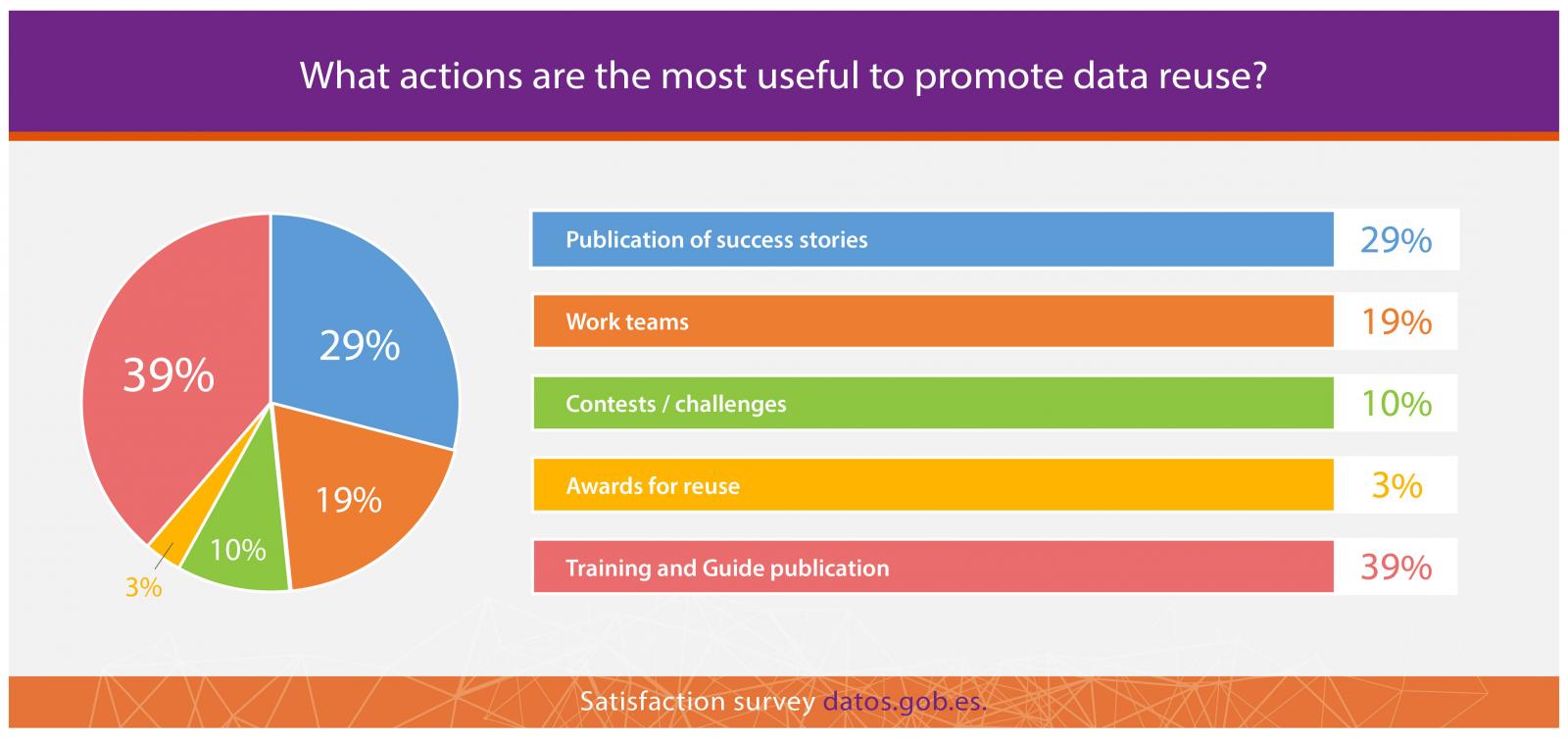
- Finally, it should be noted that the most visited datasets during the first quarter of 2019 show 3 trends: data that is aligned with the main concerns of Spaniards (unemployment, politics), data that solve everyday doubts of citizens (fuel price) or data that respond to the needs of specific professional groups (operational fishing fleet). It is important to take these factors into account when prioritizing the information to be published.

In short, providing added value services and content in an open data portal is an activity positively valued by users who visit an open data portal. Although keeping these contents updated requires an additional effort, the repercussion may be worthwhile.
As a user of datos.gob.es, do you agree with these conclusions? Share your opinion with this survey. It's only 2 minutes!
El Catálogo de datos de datos.gob.es alcanza la cifra de más de 1.000 conjuntos de datos catalogados y publicados con el objetivo de que puedan ser reutilizados por terceros.
La publicación de más de 1.000 conjuntos de datos ha sido posible gracias a la apuesta realizada desde las distintas administraciones públicas en pro de la reutilización de la información pública, y en respuesta a las solicitudes recibidas desde el sector empresarial y la ciudadanía. A través de las demandas recogidas se ha precisado la forma y el contenido de los conjuntos de datos con mayor impacto y las temáticas más demandadas, lo cual ha ayudado a las administraciones a concretar la publicación de los primeros conjuntos de datos.
La trayectoria del Catálogo de datos de datos.gob.es se inicia en octubre de 2011. En respuesta al Real Decreto 1495/2011, de 24 de octubre, por el que se desarrolla la Ley 37/2007, de 16 de noviembre, sobre reutilización de la información del sector público, para el ámbito del sector público estatal, se publican propuestas de conjuntos de datos del sector público estatal descritos de acuerdo con la Norma Técnica de Interoperabilidad de Reutilización de recursos de información. En septiembre de 2012 se inicia el servicio de soporte a la Reutilización de la Información del Sector Público (RISP) en apoyo de la publicación de conjuntos de datos y del cumplimiento del RD 1495/2011, que acelera la publicación de conjuntos de datos en el Catálogo.
A lo largo del 2013, además de la Administración General del Estado, han publicado en el Catálogo de datos.gob.es otras administraciones, tales como el Ayuntamiento de Zaragoza y el Ayuntamiento de Gijón.
El enriquecimiento del catálogo también se ha visto favorecido por la posibilidad de publicación masiva de conjuntos de datos a través de la herramienta de federación de catálogos. Gracias a esta funcionalidad es posible automatizar tanto la carga como la actualización de los datos.
Superar las 1.000 colecciones de datos ha supuesto para el equipo de datos.gob.es un logro importante, que anima a seguir apoyando a las Administraciones en su interés por la publicación de datos de calidad, así como por la puesta en marcha de diversas iniciativas que favorezcan la tendencia a una mayor apertura de la información pública y a su creciente reutilización.